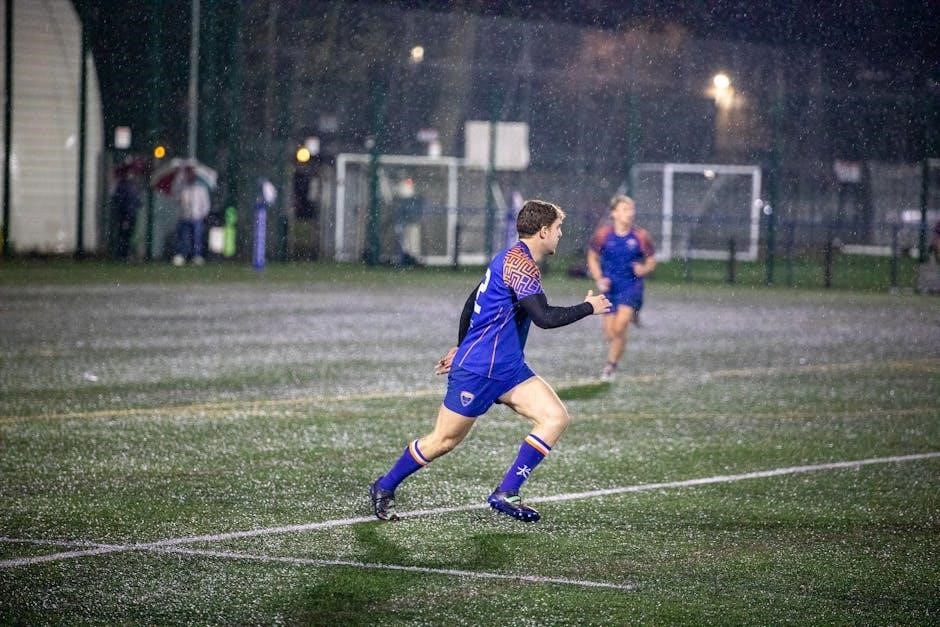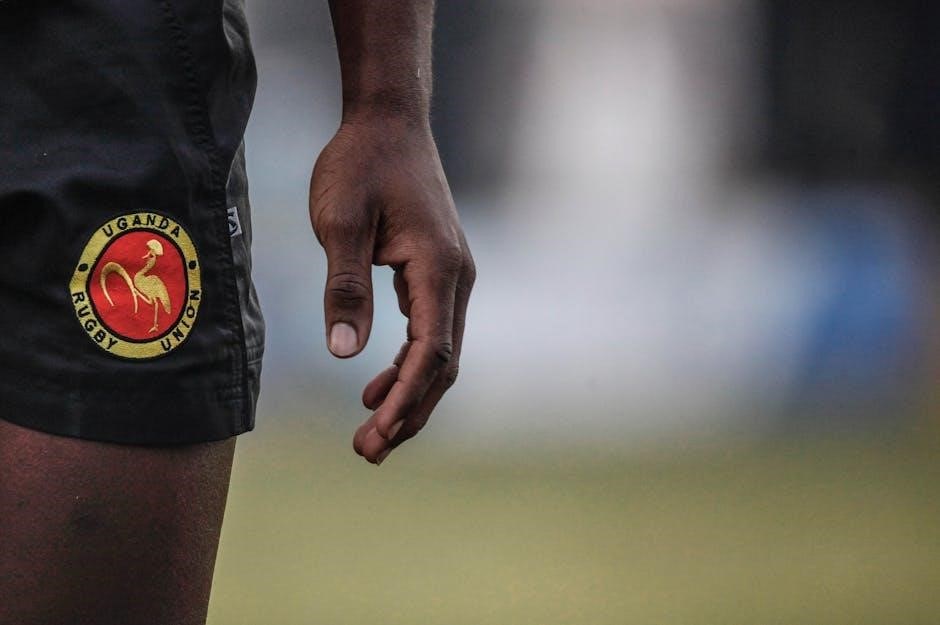
Rugby Union is governed by a comprehensive set of laws available in the World Rugby Laws of the Game PDF. These rules ensure fair play and clarity for players‚ referees‚ and fans. The official laws‚ accessible via World Rugby’s website‚ include detailed guidelines‚ video examples‚ and practical applications to enhance understanding. This resource is essential for newcomers and experienced participants alike‚ promoting consistency and enjoyment of the game worldwide.
Overview of Rugby Union
Rugby Union is a full-contact team sport played with 15 players per side‚ combining strength‚ strategy‚ and skill. The objective is to score points by carrying or passing the ball into the opponent’s goal area‚ with tries‚ conversions‚ penalties‚ and drop goals being the primary methods. The game is structured around phases of play‚ including rucks‚ mauls‚ scrums‚ and lineouts‚ which restart play after minor infringements; The World Rugby Laws of the Game PDF provides a detailed guide to these rules‚ ensuring consistency and fair play. Understanding these laws is essential for players‚ coaches‚ and referees to appreciate the game’s nuances and safety protocols.

Importance of Understanding the Rules
Understanding the rules of Rugby Union is crucial for ensuring player safety‚ promoting fair play‚ and enhancing overall enjoyment of the game. The World Rugby Laws of the Game PDF serves as the official guide‚ detailing regulations to prevent injuries and maintain integrity. Players‚ referees‚ and coaches must adhere to these laws to avoid penalties and sanctions‚ such as those outlined in Law 9.7(a) regarding intentional infringements. By familiarizing oneself with the rules‚ participants can navigate the game confidently‚ fostering respect and discipline. Additionally‚ resources like the Rugby Union Laws App and video examples provide practical tools to deepen understanding and apply the laws effectively in real-game scenarios.
Key Areas of Rugby Union Rules
Rugby Union rules cover essential aspects like foul play‚ territorial gain‚ possession‚ and restarts such as scrums and lineouts‚ ensuring a structured and fair game.
Law 9: Foul Play
Law 9 addresses foul play‚ ensuring player safety and fair competition. It prohibits intentional infringements like dangerous tackles or deliberate offenses. Sanctions include penalties or yellow/red cards.
World Rugby’s PDF details these rules‚ emphasizing respect and discipline. Video examples in the Rugby Union Laws App clarify how fouls are identified and penalized‚ helping players and referees understand enforcement. This law is crucial for maintaining the integrity and sportsmanship of the game‚ aligning with Rugby’s core values. Proper enforcement ensures a safe and enjoyable environment for all participants.
Law 9.7(a): Intentional Infringements
Law 9.7(a) prohibits players from intentionally infringing any law of the game. This ensures fair play and safety. A breach results in a penalty‚ as stated in the World Rugby Laws PDF.
For example‚ deliberate offenses like dangerous tackles or obstruction are penalized. Match officials rigorously enforce this law‚ with support from World Rugby‚ as seen in recent high-profile matches. Video examples in the Rugby Union Laws App clarify its application. This law is vital for maintaining the game’s integrity and promoting respect among players. Understanding it is essential for players and referees to uphold the game’s values and ensure a safe‚ competitive environment.

Gameplay Basics
Rugby Union gameplay involves two teams of 15 players each‚ aiming to score by carrying or passing the ball into the opponent’s try zone. The game is divided into two 40-minute halves‚ with a 10-minute halftime break. Play resumes through scrums‚ lineouts‚ or kicks‚ ensuring continuous action and strategic teamplay.
Objective of the Game
The primary objective in Rugby Union is to score points by carrying or passing the ball into the opponent’s try zone and touching the ball to the ground. Teams can also score through kicking penalties or drop goals. The team with the most points at the end of 80 minutes wins. Players must adhere to the laws outlined in the World Rugby Laws of the Game PDF‚ ensuring fair play and sportsmanship. Understanding these rules‚ including Law 9.7(a) on intentional infringements‚ is essential for players and fans to fully grasp the game’s strategy and flow. The World Rugby app and resources provide detailed guidance.
Game Duration and Structure
A Rugby Union match lasts 80 minutes‚ divided into two 40-minute halves. The game is overseen by referees who manage time‚ ensuring play flows smoothly. Stoppage time for injuries or restarts like scrums and lineouts can extend the duration slightly. Halftime provides a 10-minute break‚ allowing teams to strategize. If scores are tied at full time‚ extra time may be played to determine the winner. The World Rugby Laws of the Game PDF outlines these structures‚ while the Rugby Union Laws app offers interactive guides to help players and fans understand timing and gameplay flow. These resources ensure clarity on match duration and restart procedures.
Player Conduct
Player conduct in Rugby Union emphasizes respect‚ discipline‚ and fair play. The World Rugby Laws of the Game PDF outlines sanctions for foul play‚ ensuring a safe and sporting environment.
Respect and Discipline in Rugby
Respect and discipline are cornerstone values in Rugby Union‚ as outlined in the World Rugby Laws of the Game PDF. Players must respect teammates‚ opponents‚ and officials‚ adhering to the game’s code of conduct. Discipline ensures fair play and safety‚ with clear sanctions for misconduct. The laws emphasize that intentional infringements‚ such as foul play‚ are not tolerated and may result in penalties or other disciplinary actions. Maintaining respect and discipline upholds the integrity of the sport‚ fostering a positive environment for all participants. These principles are essential for the smooth progression of the game and its enjoyment by everyone involved.
Sanctions for Foul Play
Sanctions for foul play in Rugby Union are clearly defined in the World Rugby Laws of the Game PDF to maintain fair play and player safety. Law 9.7(a) specifies that intentional infringements result in penalties‚ ensuring accountability for deliberate offenses. Repeat or severe offenses may lead to yellow or red cards‚ temporarily or permanently removing players from the game. These sanctions uphold the game’s integrity and promote a culture of respect and discipline. By enforcing these rules‚ Rugby Union ensures a safe and sporting environment for all participants‚ aligning with the values outlined in the World Rugby Playing Charter.
Scoring in Rugby Union
Scoring in Rugby Union is detailed in the official rules PDF‚ outlining points for tries‚ conversions‚ penalties‚ and drop goals to determine the match outcome.
Try‚ Conversion‚ Penalty‚ and Drop Goal
In Rugby Union‚ scoring methods are clearly defined in the official rules. A try is worth 5 points‚ awarded for touching the ball down in the opponent’s goal area. A conversion follows a try‚ offering an additional 2 points if the ball is kicked through the opponent’s goalposts. A penalty also awards 3 points for a successful kick at goal after an infringement. Lastly‚ a drop goal is worth 3 points‚ scored by kicking the ball through the goalposts during open play. These scoring methods are outlined in the World Rugby Laws of the Game PDF‚ ensuring clarity and consistency in application.
Points Allocation
In Rugby Union‚ points are allocated based on specific scoring actions. A try is worth 5 points‚ the highest single score‚ achieved by grounding the ball in the opponent’s goal area. A conversion‚ taken after a try‚ awards 2 points if successful. Penalties and drop goals each award 3 points‚ with penalties scored from a placed kick and drop goals from an open play kick. These scoring methods are clearly outlined in the World Rugby Laws of the Game PDF‚ ensuring consistency and fairness. Understanding these point allocations is crucial for players‚ officials‚ and fans to fully engage with the game’s dynamics and strategies.

Restarting Play
Restarting play in Rugby Union involves methods like scrums‚ lineouts‚ and kicks to resume the game after stoppages. These restarts ensure continuous flow and fair play.
Scrums and Lineouts
Scrums and lineouts are key methods to restart play in Rugby Union. A scrum forms when the ball is fed into a tunnel created by opposing players’ heads and shoulders. Lineouts occur when the ball goes out of bounds‚ and players form a line to catch a thrown-in. Both restarts require precise formation and adherence to laws to ensure safety and fair play. Scrums involve eight players binding together‚ while lineouts involve teams competing for possession. Proper technique and officiating are crucial to prevent injuries and maintain the game’s flow‚ as outlined in the World Rugby Laws of the Game PDF.
Kicks: Penalty‚ Drop Goal‚ and Restart

Kicks are a fundamental aspect of Rugby Union‚ with specific rules governing their execution. A penalty kick is awarded for intentional infringements‚ allowing the attacking team to attempt a goal or restart play. A drop goal is scored when a player kicks the ball through the opponent’s posts during open play‚ worth three points. Restart kicks‚ such as 22-meter dropouts‚ are used to resume play after the ball goes out of bounds. These kicks must be executed correctly‚ with the ball dropping from hand to ground before being kicked. The World Rugby Laws of the Game PDF provides detailed guidelines on the proper techniques and sanctions for illegal kicks‚ ensuring fair play and maintaining the game’s integrity.
Ball in Play
The ball is in play unless the referee stops it for a foul or the ball goes out of bounds. Play resumes through rucks‚ mauls‚ or kicks.
Territorial Gain and Possession
Territorial gain in rugby is achieved by advancing the ball forward through carrying‚ passing‚ or kicking. Possession is retained when players maintain control of the ball. Teams aim to progress the ball into the opponent’s territory while defending their own. This dynamic balance is central to the game’s strategy. Rucks and mauls are key phases where possession is contested after a player is tackled. Players must release the ball upon being tackled‚ allowing the opposing team to contest for it. Intentional infringements‚ such as not releasing the ball or obstructing play‚ result in penalties. Effective territorial gain and possession management are crucial for scoring opportunities and overall success in a match.
Rucks and Mauls
A ruck is formed when a player carrying the ball is tackled and released‚ creating a contest for possession. Players from both teams must stay on their feet‚ not handling the ball‚ and attempt to win it back. A maul forms when the ball carrier is held by opponents but remains on their feet‚ with teammates supporting them. Both phases require strict adherence to rules to ensure player safety and fair play. Intentional infringements‚ such as collapsing a maul or not releasing the ball‚ result in penalties. Effective ruck and maul management is critical for maintaining possession and creating attacking opportunities in rugby union.

Key Positions and Roles
Rugby Union players are divided into forwards and backs. Forwards focus on physical contests like scrums and lineouts‚ while backs emphasize speed and strategic play. Positions like scrum-half and fly-half are crucial for coordinating attacks and tactical decision-making‚ ensuring effective teamwork and adherence to game rules.
Forward and Back Positions
In Rugby Union‚ players are divided into forwards and backs‚ each with distinct roles. Forwards‚ including props‚ hookers‚ locks‚ flankers‚ and number eights‚ engage in physical contests such as scrums and lineouts‚ focusing on gaining possession and territorial advantage. Their primary responsibilities include winning set-piece battles and breaking defensive lines. Backs‚ comprising scrum-halves‚ fly-halves‚ centers‚ wings‚ and fullbacks‚ prioritize speed‚ agility‚ and strategic play. They execute attacking plays‚ create scoring opportunities‚ and maintain defensive structures. The collaboration between forwards and backs is essential for a balanced and effective team performance‚ as outlined in the World Rugby Laws of the Game PDF.
Role of the Scrum-Half and Fly-Half
The scrum-half and fly-half are pivotal positions in Rugby Union‚ as outlined in the World Rugby Laws of the Game PDF. The scrum-half acts as the link between forwards and backs‚ feeding scrums‚ distributing the ball‚ and controlling the tempo of the game. They are responsible for quick decision-making and accurate passing. The fly-half‚ often the playmaker‚ directs backline attacks‚ executes tactical kicks‚ and manages game strategy. Both positions require excellent vision‚ leadership‚ and adaptability. Their coordination ensures effective transition from defense to attack‚ making them indispensable to the team’s offensive and defensive structures. Their roles are clearly defined to maintain game flow and compliance with the laws.

Match Officials
Referees and assistant referees enforce Rugby Union laws‚ ensuring fair play and player safety. The Television Match Official (TMO) assists with key decisions‚ enhancing accuracy and maintaining game integrity.
Referee and Assistant Referees
The referee is the ultimate authority on the field‚ interpreting and enforcing Rugby Union laws during matches. Assistant referees support the referee‚ focusing on specific areas like offside and foul play. Together‚ they ensure fair play‚ maintain discipline‚ and promote player safety. Their decisions are crucial for the smooth progression of the game. The World Rugby Laws of the Game PDF outlines their roles and responsibilities‚ providing detailed guidelines for consistent officiating. Proper training and adherence to these laws enable referees to uphold the game’s integrity effectively.
Role of the Television Match Official (TMO)
The Television Match Official (TMO) plays a pivotal role in Rugby Union‚ assisting referees by reviewing key incidents during matches. Using video technology‚ the TMO evaluates decisions such as tries‚ foul play‚ and touchline crossings. Their input ensures accuracy in crucial moments‚ enhancing the fairness of the game. The World Rugby Laws of the Game PDF details the TMO’s responsibilities‚ outlining protocols for when and how to intervene. This role has significantly improved decision-making‚ maintaining the integrity of the sport while aligning with its core values of respect and discipline.
Resources for Learning
Access the official World Rugby Laws of the Game PDF for detailed rules and guidelines. The Rugby Union Laws app offers interactive learning tools and video examples to enhance understanding.

World Rugby Laws of the Game PDF
The official World Rugby Laws of the Game PDF is a comprehensive guide outlining all rules for Rugby Union. Available for free on the World Rugby website‚ it covers laws for match play‚ foul play‚ and specific scenarios. The document includes detailed explanations‚ examples‚ and visual aids to enhance understanding. It also provides variations for different formats‚ such as Under 19 Rugby and Sevens. This PDF is essential for players‚ coaches‚ and referees to ensure clarity and consistency in the game. Regular updates reflect changes in the sport‚ making it a reliable resource for staying informed about the latest regulations.
Rugby Union Laws App
The Rugby Union Laws App offers a convenient way to access the game’s rules on iOS and Android devices. Developed by World Rugby‚ the app provides the official laws‚ video examples‚ and interactive tools to test knowledge. Users can explore specific laws‚ watch match clips‚ and take quizzes to enhance their understanding. The app is designed for players‚ referees‚ and fans‚ ensuring everyone stays updated on the latest regulations. Regular updates keep the content current‚ making it an indispensable resource for anyone involved in Rugby Union. The app complements the PDF version‚ offering a modern‚ mobile-friendly way to engage with the game’s rules anytime‚ anywhere.

Practical Application
The World Rugby Laws of the Game PDF and app provide video examples‚ case studies‚ and quizzes to test understanding. These tools help players and referees apply the rules effectively in real-game scenarios‚ ensuring consistency and fair play.
Video Examples and Case Studies
World Rugby offers video examples and case studies within their Laws of the Game PDF and app to illustrate real-match scenarios. These resources provide clarity on how rules are applied‚ such as Law 9.7(a) intentional infringements. They cover key decisions‚ like penalties and sanctions‚ helping referees and players understand correct interpretations. Case studies from matches‚ including high-profile games‚ demonstrate practical applications of the laws. These tools enhance learning by showing real-life examples‚ ensuring consistent understanding and application of the rules across all levels of play.

Quizzes and Tests for Understanding
The World Rugby Laws of the Game PDF and app include quizzes and tests to assess understanding of rugby union rules. These interactive tools feature multiple-choice questions‚ true/false statements‚ and scenario-based tests. They cover key areas like foul play‚ territorial gain‚ and scoring methods. Quizzes are designed to reinforce learning‚ ensuring players and referees grasp the rules accurately. The app also provides immediate feedback‚ highlighting correct answers and explaining mistakes. These resources are ideal for both newcomers and experienced participants‚ offering a practical way to test knowledge and improve comprehension of the game’s laws. Regular use enhances decision-making and confidence in applying the rules effectively.